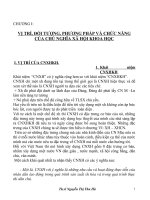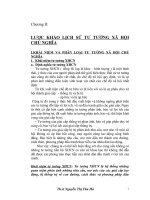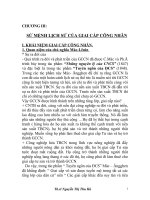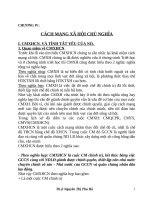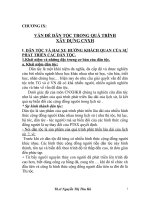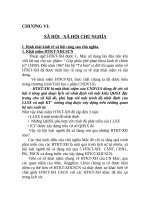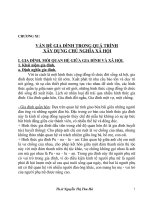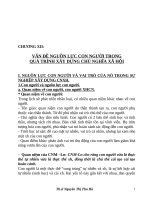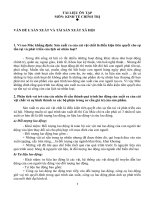Presentation on Merchandising
Bạn đang xem bản rút gọn của tài liệu. Xem và tải ngay bản đầy đủ của tài liệu tại đây (3.33 MB, 49 trang )
GARMENTS MERCHANDISING
Prepared By : Mazadul Hasan sheshir
ID: 2010000400008
13
th
Batch (session 2009-2013)
Department : Wet Processing Technology
Email:
Blog : www. Textilelab.blogspot.com (visit)
Southeast University
Department Of Textile Engineering
I/A 251,252 Tejgaon Dhaka Bangladesh
Prepared By :
Total Texle Process at a Glance
Introductio n
The “Merchandising” is known to the persons specially involved in
garments trade. The term merchandising has been derived from the
merchandise. Merchandise means goods that are bought & sold.
The term “Merchandiser” may be defined as Person who
merchandises the goods, specifically for export purposes. Garments
merchandising means buying raw materials & accessories,
producing garments, maintaining required quality level and
exporting the garments within schedule time.
Merchandising is the business art of matching goods to the needs
and preferences of customers to ensure shelf off take. How a
product is presented, how much is displayed, and in what form, size
shape, color, etc. can determine the rate of speed at which a
product is bought.
In other words merchandising is the marketing activity responsible
for ensuring a product’s “desirability”, both qualitatively and
quantitatively. This means that at the store end, your product has
to be perceived as “just right” by your market. It is a whole lot of
psyche satisfaction. The personnel who acts the merchandising
activities is called “Merchandiser”.
Objectives of Garments Merchandising
1. To try to get garments order inquiry from buyer
through various sources.
2. To find out the consumptions of fabrics &
accessories.
3. To make costing on the garments inquiry.
4. Procurement of raw materials.
5. Follow up.
6. Regular correspondence with buyer, suppliers
and related personnel.
7. Help and follow up in commercial activities.
8. Arrange tests & inspections.
9. To do shipment.
Work flow of Garments
Merchandising
To collect buyers addresses.
To establish contact with the buyers sending formal letters/profile.
Receiving buyer’s response and providing price quotation along with making of sample as
counter/approval.
Receiving samples comments from the buyer.
Receiving Purchase Order from buyer.
To furnish the pro-forma invoice and sending the buyer.
Receiving the master L/C & verify clauses of the L/C both in technical and commercial point
of view.
To estimate time schedule for the exports of those garments as per L/C.
To confirm floor booking of the order with factory.
Taking necessary steps to develop lab-dips of the materials (FAB & ACC)
To confirm transfer authentication of the L/C in favor of fact.
Pushing the factory taking initial procurement to open the back-to-back L/C by bank.
Searching reliable fabric and accessories sources and finalize supplying of the required
materials relevant to the order.
To monitor the shipment of raw materials and arrival in the factory.
To monitor of the supplying materials while receiving factory.
To order the test cutting with quality.
To check/inspect/advise for the bulk production.
To monitor production, quality and delivery.
To advise factory if buyer change any instruction both in technical/commercial point of view
to the order.
To maintain continuous liaison with his or her controlling authorities.
Arrange inspections.
Sea vessel / air ship booking & insurance
Shipment
Some Influential Buyer’s Name
Calvin Klein
Tommy Hilfiger
Armani Exchange
Dolce and Gabbana
Mark and Spencer
Zara
Nike
Matalan
Primark
Ted Barker
PUMA
Diesel
Levis
Lee Cooper
Police Brand
U. S. Polo
Massimodutti
Bershka
Pullandbear
River Island
Diesel
Austin Reed
Blue Inc
ASOS
Ann Harvey
Jack Willis
Topshop
Boden
Vera Wang
Valentino
Ralph Lauren
Max Mara
Hugo Boss
Next
H&M
Lacoste
Gap
Forever 21
Forever New
FCUK
Laura Ashley
House of Fraser
Debenhams
New Look
Lagos
Trussardi
Explosion
Ed Hardy
Dsquared
Sisley
Aftershock
Promod
Mango
La Senza
Karen Miller
Esprit
Tesco
by buyers
FOB(free on board) Order
FOA(Free on Air) Order
C& F(Cost & Freight) Order
CIF(Cost Insurance & Freight) Order
CIFC(Cost Insurance & Freight & Commission)
Order
FOB: This is the export term of delivery and price quotation. The
sellers send the goods for export and deliver them on ship. The risk is
passed from seller to buyer when the goods are loaded in the ship at
the port of departure. The buyer paid the freight charges. The seller
doesn’t include the freight charge with his costing.
FOA: The supplier delivers the goods to the air Carrier at the air port of
departure, the buyer bear the risk from that moment and pays the air
transport cost. The seller bears the cost of materials and making,
doesn’t include air freight.
C&F: The sellers send the goods for export & pay the freight charge
and deliver them on ship. The risk is passes to the buyer when the
goods are left the port of departure as buyer recommends the
shipping line.
CIF (Cost Insurance & Freight): The seller ensures the goods against
loss and damage at his own cost.
CIFC(Cost Insurance & Freight & Commission) : The seller includes the
cost of insurance, freight and commission for local buying house.
TIME AND ACTION CALENDAR
Normally merchandisers prepare a
plan in a spreadsheet listing down key
processes in one column and planned
date of action for each process is noted
in another. This planning sheet is
called time and action calendar. Once
TNA calendar is made, merchandiser
can easily list down her daily 'to do
list' for the day and start doing work
one by one. According to TNA schedule
processes are executed on daily basis
to track whether an order is on track
or getting delayed.
T&A Calendar
SAMPLE
The samples decide the ability of an
exporter. The buyer will access the exporter
and his organization only by the samples. If
the samples are of good quality and with
reasonable price naturally the buyers will be
forced to place the order. So it is essential
that the samples should be innovative and
with optimum quality. The purpose of
sampling is not only to get bulk orders and
also give some additional benefits to the
exporters. By doing sampling the exporter
can estimate the yarn consumption for
developing the fabric, a clear idea on costing
more ever the manufacturing difficulties.
Types of Sample
Salesmen samples or promotional samples
Proto samples
fit samples
Pre-production samples
Size-set sample
Production samples
Shipment samples
Proto Sample: This samples are proto type of new design created by
designers. This is the first sample in product development stage. Proto
sample is made to communicate the design of a style or a line or to
present garment structure. In proto samples fit and fabric detailing is not
been considered.
FIT Sample: Once proto sample is approved, FIT is being made with actual
measurement. Modification on the pattern is done to get desired fit of the
garment. FIT is one of the most important factor to be considered during
sample development. FIT sample is being tested on live model or Dress
form for to verify garment fit and fall.
Salesman Sample: Salesman samples are made to put on display in the
retail showroom. Salesman sample (SMS) are displayed for assessing
customer's feedback and according to customers response buyers forecast
demand of an particular style. Sales samples are made with actual fabric
and trims and accessories. Buyer pays for salesman samples to the
developer.
Size set Sample: The purpose of the size set is to check fit of the
garment in different sizes. In this stage factory develops samples in
multiple sizes. Generally, buyers ask size set sample in jump sizes,
like S, L, XXL. Buyer check size set sample and give feedback to
factory if anything need to be corrected.
Pre-production Sample: All the above samples are made in sampling
department. Buyer wants pre-production sample (PP sample) to be
made in actual production line, so that operators know what are they
going to make. This sample is made with actual fabric, trims and
accessories and made by sewing line tailors. PP sample must be
approved by buyer or buying house merchants (technical persons)
prior to proceeding actual production.
Shipment Sample: When style is being finished and packed for
shipment, 2-3 finished and packed pieces with all packing details are
kept for future reference. Shipment sample is kept by factory
merchants and buyer's merchant. The approved shipment is sent
directly to warehouse and merchants at the buyer do not get
garment out of the shipment. That is why they keep shipment sample
for future reference.
Consumption & Costing
Knit garments consumption:
Fabric Consumption:
Before calculate the fabric consumption, we must
need the followings information as mentioned
below:
1) Measurement chart with technical spec.
2) Style Description.
3) Fabric Description.
4) Fabrics width/weight.
5) Washing shrinkage if any.
Calculation:
{(Body length + Sleeve length +
Sewing Allowance) X (1/2 Chest
+ Sewing Allowance)}X 2 X GSM X 12 /
10000000 + Wastage (For 12 pcs of garments)
Woven Garments Consumption:
Fabric Consumption:
Formula = Length X Width / Fabric width X
Fabric Unit
Cost of Manufacturing (CM) Calculation:
COST OF MAKING (CM) ={(Monthly total
expenditure of the following factory / 26) / (Qty
of running Machine of your factory of the
following month) X (Number of machine to
complete the layout)} / [{(Production capacity
per hr from the existing layout, excluding alter
& reject) X 8}] X 12 / (Dollar conversion rate)
